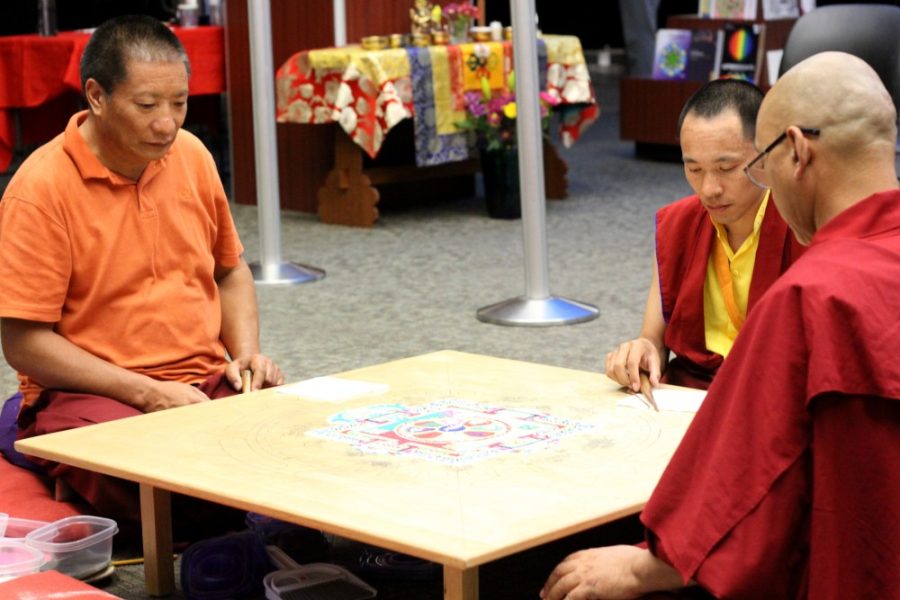As part of a religious studies expansion, the UA has brought three Buddhist monks to campus where they are currently creating a mandala from only colored sand, to wash it away Thursday after five days of tedious work.
“The mandala is representative of our bodies,” said Lama Tensin, one of the monks. “Our body one day is gone; our life is gone second by second.”
The sand-made mandala is common practice in Tibetan Buddhism as part of their belief in impermanence. The mandala design is drawn out on the surface where they then use funnels to carefully lay out different colored sands.
The mandala symbol itself is sacred. In addition to being a metaphor for our bodies, it represents a world in harmony and peace. After praying over it, they will dissolve it with water, leaving no trace of the design. In a moment, it will all be gone.

The water, with the sand dissolved in it, will be taken with the monks. Some will be kept at their Buddhist school, and the rest will be released into a stream, blessing the rest of the world.
Lama Tensin, along with Lama Norbu, came to assist Drupon Thinley Ningpo Rinpoche, the monk headlining the event and giving a lecture April 4.
Drupon and Rinpoche are both honorary titles. Drupon means “master of spiritual-attainment,” which Thinley Ningpo obtained after studying in the Drikung Kagyu Institute at the Jangchubling Monastery in the foothills of the Himalayan mountain range in northeast India.
The event was organized by the recently hired professor Rae Erin Dachille, who holds a doctorate in Buddhist studies from the University of California, Berkeley. The event is in conjunction with the university expanding its religious studies major to incorporate Tibetan Buddhism.
RELATED: Vietnamese Student Association to host pageant, showcase Tucson Vietnamese community
Dachille has organized the showing of this ritual art form at other universities. The event was largely funded by the Arizona Friends of Tibet, but also received support from both the departments of religious studies and East Asian studies.
She started by reaching out to a college from Berkeley who used to translate for the Drikung Namgyal Ling, the temple Drupon teaches at. It just so happened the whole event would work out.
“We decided we wanted to proceed without figuring out where the funding would come from,” professor Dachille said. “The event was organized in the past three-and-a-half weeks.”
Drupon currently teaches at the Drikung Namgyal Ling, the Drikung Kagyu Buddhist Center of Tucson in Sahuarita. The organization was formed in May 2004 and recognized by the State of Arizona as a religious nonprofit in August 2004.

Drikung Kagyu derives its school from the Kagyu School of Buddhism, one of four major branches of the Tibetan religion.
Many of the religious studies students, both graduate and undergraduate, came to the event to talk to Drupon about various aspects of Buddhism.
“Aside from participation points for the class, it’s an amazing event,” said Nick Noble, a religious studies senior.
Although Noble isn’t Buddhist himself, he does take an interest in the subject, taking many Buddhist-focused courses through the major.
“There are a lot of opportunities to learn from Buddhism,” he said.
The monks are creating the mandala on the bottom floor of the UA Bookstore every day from 9 a.m-5 p.m. It is open to public.
Follow Steven Spooner on Twitter.








